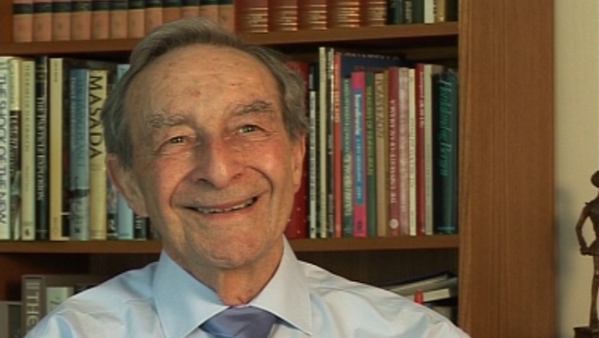NEXT STORY

Paul Dirac's inspiring lectures
RELATED STORIES

NEXT STORY

Paul Dirac's inspiring lectures
RELATED STORIES


|
Views | Duration | |
|---|---|---|---|
| 71. The surprising results of our boron trifluoride experiments | 57 | 02:42 | |
| 72. Addressing the points raised by my PhD research | 44 | 05:24 | |
| 73. Paul Dirac's inspiring lectures | 471 | 02:33 | |
| 74. Skiing in Norway for Easter vacation | 53 | 00:46 | |
| 75. The trip of a lifetime | 47 | 07:58 | |
| 76. Final year and post-doc in Cambridge | 55 | 02:41 | |
| 77. A great expedition to Lapland | 45 | 03:28 | |
| 78. 'You don't know about Norway's mosquitoes!' | 209 | 01:17 | |
| 79. Preparations for the Lapland expedition | 39 | 00:56 | |
| 80. The end of civilisation | 49 | 02:38 |


It comes really as little surprise that if you put two compounds together and they start sharing electrons to form a new bond, that the electric balance within the molecule is altered. And I say it should come as no surprise because a very famous experiment which was done here in Leeds, actually, by Joseph Priestley when he was minister in City Centre at Mill Hill chapel there, he was doing experiments all the while and apart from some that are very well known, one that is perhaps less well known is that he succeeded in isolating several – I think about half a dozen – completely new gases which had not been isolable before because people were working in aqueous water-like solutions, and these compounds decompose in water.
And Priestley said, 'I wonder if they would decompose in mercury?' Mercury, as you know, is a liquid from thermometers and so forth – we know this – it is a liquid down to -40 degrees, and I don't have to say Celsius or Fahrenheit because -40 happens to be the same number in both Celsius and Fahrenheit. But anyway, that is a liquid at room temperature, and so he collected the liquids that he was... the gases that he was making, not under water but over mercury, and then he could handle these gases. And two of the gases that he made in that way were ammonia, NH3, and hydrogen chloride gas, HCl, another molecule.
And what Faraday did... sorry, Priestley did was, when he mixed these he just expected they would float around, perhaps, or perhaps interact to give a new compound. What happened totally astounded him. The pressure dropped to zero, and there was a white cloud, and just some crystals formed on the outside... on the side of the glass. And what had happened of course is, he'd made ammonium chloride, because NH3, covalent molecule, HCl, put them together, the hydrogen gets transferred to the nitrogen, ammonium with a positive charge, chlorine – they are ionic, they form a crystalline solid, and it's there. So that he discovered that by working under mercury you could do many experiments that you couldn't possibly do in aqueous solutions.
So people shouldn't perhaps have been surprised that this would go on to a greater or lesser extent, and water, which in many ways is very similar to ammonia, is a good case in point. What happens there is, I found, because this was part of my experiment – I'm keeping off the parts that Ray did – but if you put hydrogen, dihydrogen oxide, that is to say water, with boron trifluoride, you form a very unstable liquid, but if you put two molecules of water you form a very stable liquid. That seemed very strange: why should the two-to-one complex be more stable? But when you think of ionisation it becomes obvious: what happens in the first place is, you've got H2O coming onto BF3, you've got a molecule which then tries to split apart. If it tries to do the ammonia trick it gives H3O+, and BF3OH-. Well, I'm sorry – I must backtrack on that, because I'm making a mistake. It would give H+ and BF3OH- and the H+ by itself is very unstable; it can take up another water molecule to form H3O+. So that's then two molecules of water, and that is the stable one. But the interesting thing about it is that both of those compounds, both very reactive, in the liquid phase are ionised, and the two-to-one is the stable compound. Interestingly, when you crystallise this compound... later experiments have shown – experiments done by groups in Oxford – that in fact it is a molecular compound in the solid state.
Norman Greenwood (1925-2012) was born in Australia and graduated from Melbourne University before going to Cambridge. His wide-ranging research in inorganic and structural chemistry made major advances in the chemistry of boron hydrides and other main-group element compounds. He also pioneered the application of Mössbauer spectroscopy to problems in chemistry. He was a prolific writer and inspirational lecturer on chemical and educational themes, and held numerous visiting professorships throughout the world.
Title: Addressing the points raised by my PhD research
Listeners: Brian Johnson
Professor Brian FG Johnson FRS, FRSE, FRS Chem, FAcad Eu, FAS. Professor of Inorganic Chemistry University of Edinburgh 1991-1995, Professor of Inorganic Chemistry University of Cambridge 1995-2005, Master Fitzwilliam College Cambridge 1999-2005. Research interests include studies of transition metal carbonyls, organometallic chemistry, nano- particles and homogeneous catalysis. Professor Johnson is the author of over 1000 research articles and papers.
Tags: University of Leeds, Mill Hill Unitarian Chapel, Joseph Priestley
Duration: 5 minutes, 24 seconds
Date story recorded: May 2011
Date story went live: 25 November 2011